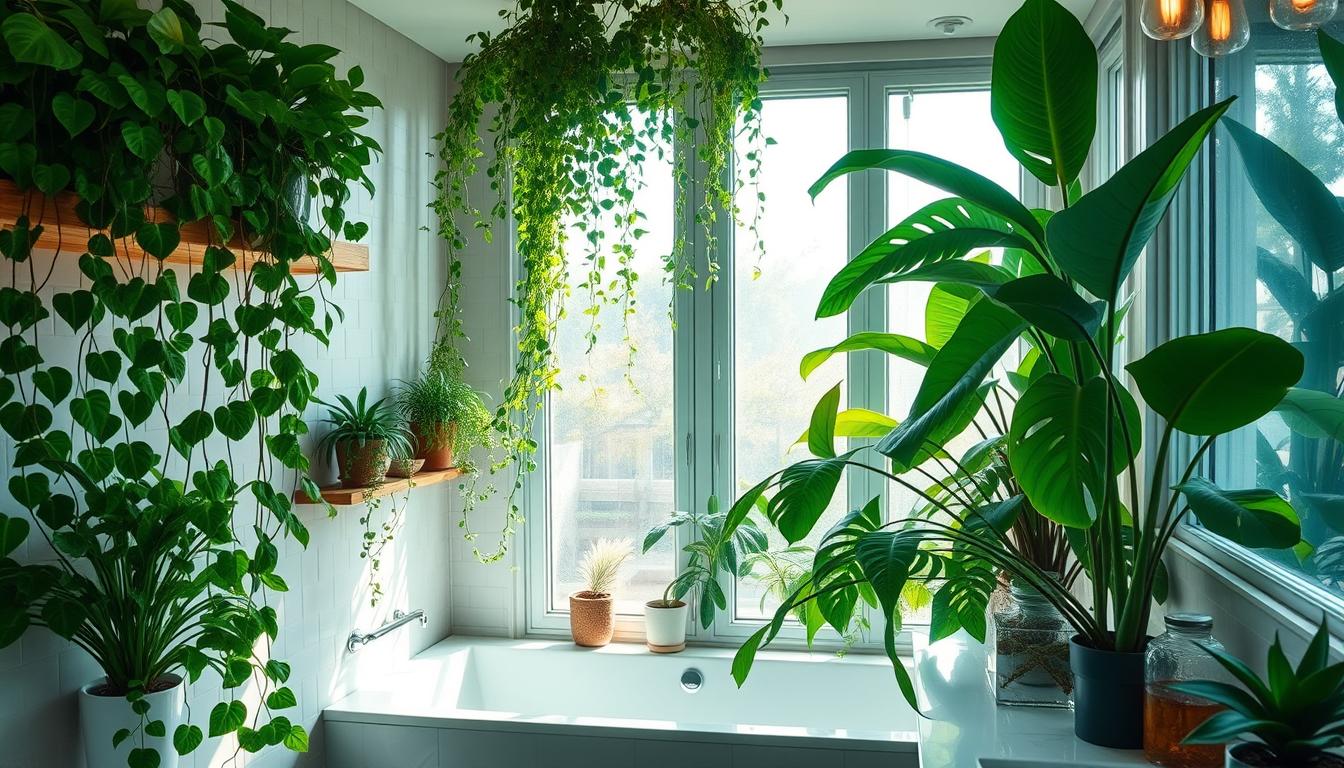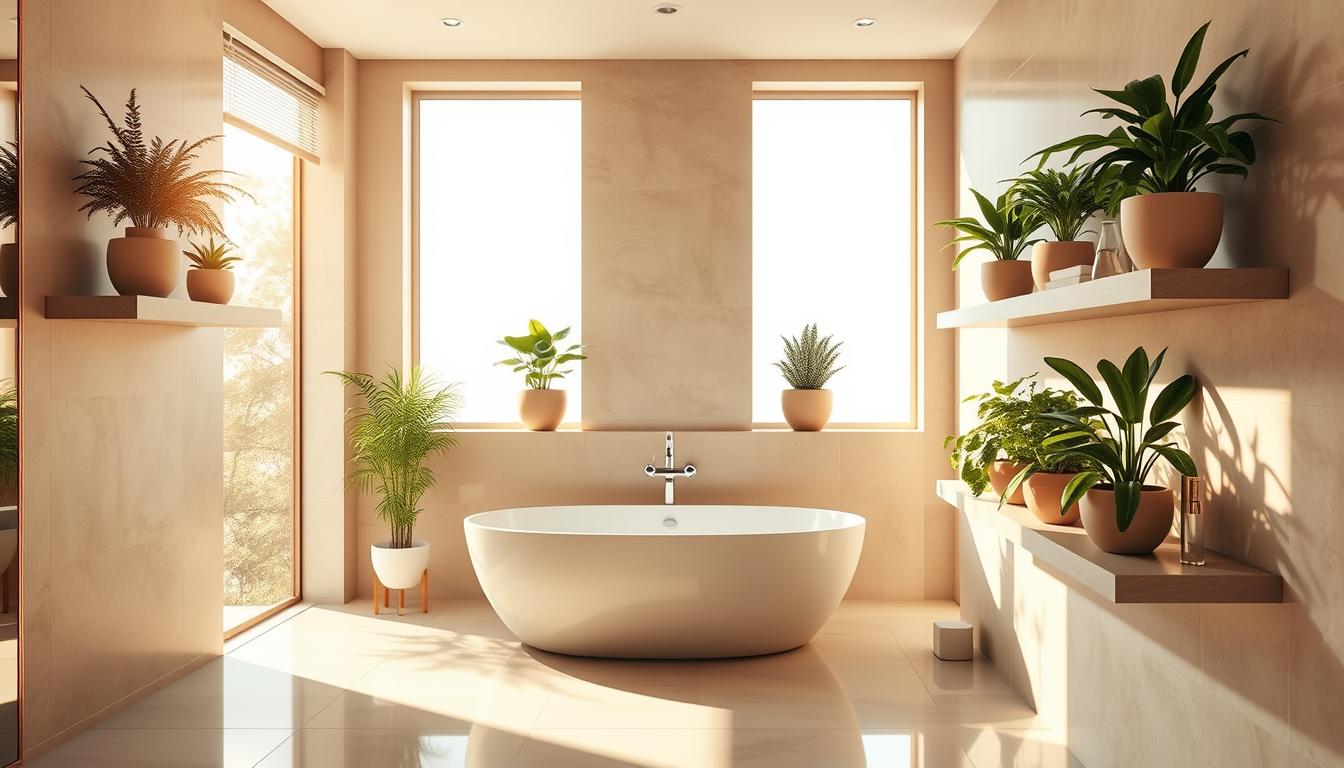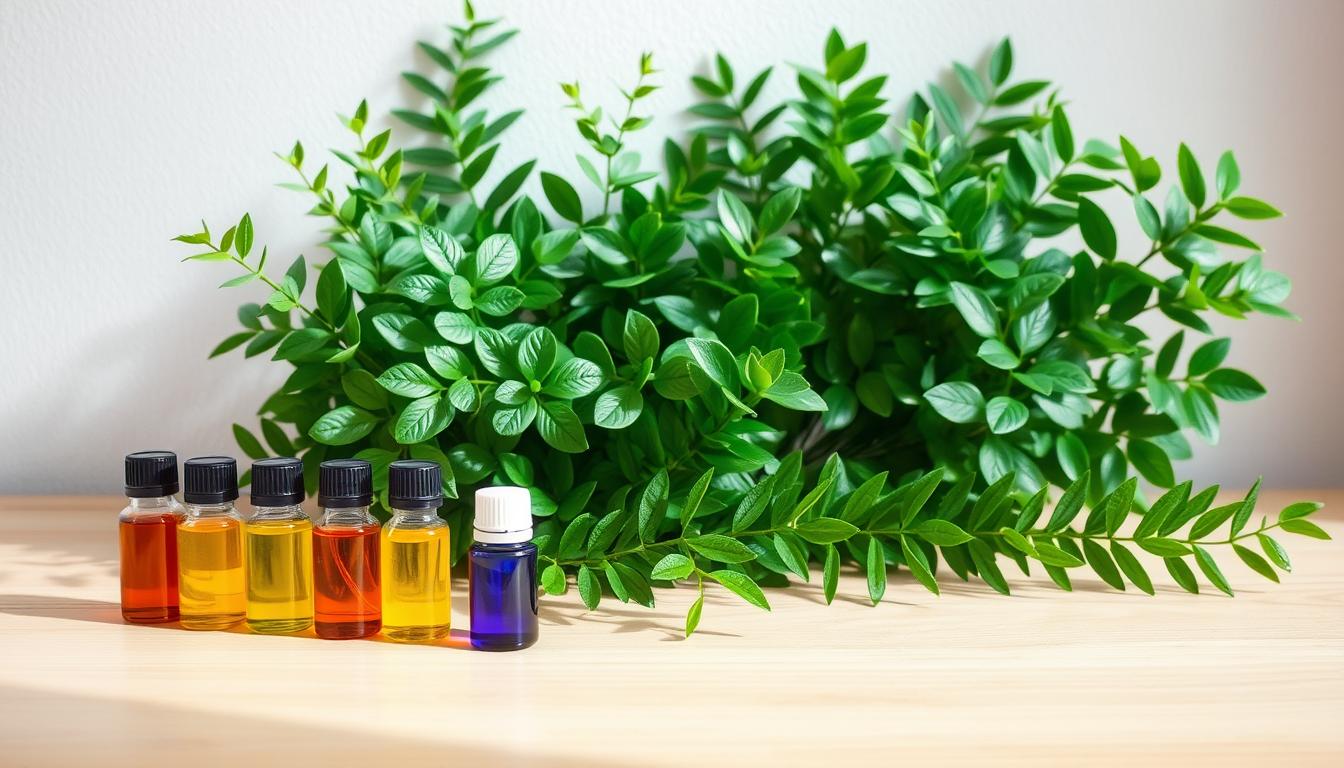In bathroom decor, fake plants add green without real plant fuss. Yet, these fake greens gather dust, raising challenges. This text explores how these plants up health risks in moist bathroom settings. Cleanliness is key here.
The U.S. Department of Housing and Urban Development warns about low-quality materials. These can collect dust and allergens. Knowing which fake plants worsen air quality is crucial for a clean bathroom.
Introduction to Dust Accumulation in Bathrooms
Bathrooms face special problems when it comes to dust. The high moisture from showers and baths helps dust stick around. This makes it easy for dust to gather over time.
Sources of bathroom dust include skin flakes, hair, and lint. These can make surfaces dirty and hurt the air we breathe. Mixing moisture with dust also leads to mold, which can harm our health.
It’s vital to keep bathrooms clean for a healthy home. Knowing about dust and how it affects air quality can guide us to clean better. This helps everyone stay healthy.
Understanding Fake Plants: Beauty with a Hidden Cost
Fake plants look great, especially in bathrooms with little sunlight. They bring life and color to the space. However, they come with hidden costs that aren’t always clear at first.
The materials like plastic used to make them are bad for the environment. Making and getting rid of plastic hurts our planet long-term. This takes away from the beauty of artificial plants by adding to plastic pollution.
Even though fake plants don’t need water, they get dirty easily. They collect a lot of dust and need regular cleaning. This means you’ll spend time keeping them clean. Knowing this helps decide if fake plants are right for your bathroom.
Dust Magnet Analysis: Which Fake Plant Species Suffer Most in Bathrooms?
Fake plants are a popular choice for bathroom decoration because of their beauty and ease of care. However, not everyone knows that some faux plants attract a lot of dust in such environments. Learning about the common types found in bathrooms helps understand which are more likely to gather dust.
Common Types of Faux Plants in Bathrooms
Many fake plants can be found in bathroom spaces. They often include:
- Silk foliage
- Plastic succulents
- Artificial orchids
- Fabric ferns
- Vinyl vines
These plants add a touch of green and coziness. Yet, how much dust they gather depends a lot on what they’re made of. For example, silk plants with their textured surfaces tend to hold more dust than the smoother plastic ones.
Why Some Faux Plants Attract More Dust Than Others
Different fake plants attract dust for various reasons. These reasons include:
- Material Composition: Silk varieties, with their detailed textures, catch dust easier than smooth plastic ones.
- Surface Area: Larger leaves or more complex shapes mean more places for dust to land.
- Static Electricity: Some materials can attract dust more due to static charge.
This mix of factors leads to different amounts of dust on fake plants. It makes people think about how best to keep their bathroom plants clean.
The Impact of Humidity on Dust Accumulation
Humidity is a big player in how much dust gathers in bathrooms. When the air is moist, dust sticks more to surfaces, increasing buildup. As humidity goes up, it can make controlling indoor air tougher, leading to more dust and allergens.
It’s key to know how humidity and dust are linked to keep inside air healthy. Too much moisture makes a perfect home for dust mites. So, it’s vital to control bathroom humidity with good ventilation and dehumidifiers.
Keeping the indoor climate right is crucial for decoration and health. By managing humidity, we can keep dust down and air quality up. Simple steps, like opening windows or using fans, fight humidity effects. This keeps bathrooms cleaner and healthier.
Health Risks Associated with Dust Accumulation
Dust in bathrooms does more than look bad; it’s a health hazard. These small spaces let allergens and irritants grow. This can cause breathing problems. Cleaning often, especially fake plants, makes the air healthier.
Mold and Respiratory Issues Related to Dust
Dust can hold moisture, which lets mold grow. This is bad news for people with lung problems. Mold spores in the air can make indoor air quality bad. They can start allergies or make asthma worse.
- Coughing and sneezing
- Shortness of breath
- Throat irritation
- Worsening of asthma symptoms
Knowing how dust, mold, and health are linked shows why cleaning is important. Keeping things like fake plants dust-free improves the air. This makes where we live safer from mold and breathing issues.
How to Identify Dust-Catching Faux Plants
Spotting dust on faux plants helps better your indoor air. Look closely at faux plants’ details to spot dust traps. For example, plants that look very much like real ones often catch more dust in their detailed parts.
The type of material used in faux plants matters too. Porous materials catch dust easier and are tougher to clean. If your faux plant is dark or has complex designs, it might show dust more. Check your decor to see which plants need more care.

To keep your faux plants clean, regular care is key. Inspect and clean them softly to avoid dust pile-up. This keeps your fake plants looking their best and your room healthier and prettier.
Tips for Keeping Your Fake Plants Dust-Free
Keeping your faux plants clean is key for their look and your health. Regular cleaning makes them look better and keeps dust away indoors. Here are some top maintenance tips to keep your artificial plants fresh.
Cleaning Methods for Faux Leaves and Flowers
There are a few ways to clean faux plants well:
- Wiping the leaves with a damp cloth helps remove dust gently.
- Soft dusters get into tight spots to clean without damaging the plant.
- Vacuum attachments for delicate stuff can take off dust safely.
Frequency of Cleaning when Using Faux Plants in Bathrooms
Cleaning often is crucial to stop dust, especially in moist bathrooms. Keep these points in mind:
- Clean your fake plants weekly to keep them neat and stop dust from gathering.
- Do a detailed cleaning every month to keep your plants looking bright and free from dust.
Why Choose Natural Plants Over Fake Ones?
Natural plants have many advantages over fake ones. They can make the air inside better to breathe. This is because they take in carbon dioxide and let out oxygen. They also get rid of harmful toxins in the air.
Natural plants also keep the humidity at a good level. This can stop mold from growing. Your bathroom will not only look nice but will be healthier too.
Looking for plants that do well in bathrooms? Here are some good ones:
- Peace Lily: It cleans the air and thrives in low light.
- Spider Plant: Adds greenery and is good for indoor air.
- Boston Fern: Loves humidity, so it’s perfect for bathrooms.
- Snake Plant: Easy to care for and cleans the air well.
Choosing natural plants means enjoying their benefits without the dust that fake plants collect. They bring beauty and life to any room.
Conclusion
In summary, this article shows how faux plants affect bathroom looks and health. These plants can make a space look nice but also trap dust. This could be a health risk. It’s important to clean these plants regularly to keep the air clean.
When choosing between faux and real plants for bathrooms, think about health and the environment. Real plants help clean the air, making your space healthier. They are a smart choice for those who want to improve their bathrooms.
Choosing plants wisely helps make your home safer and more enjoyable. Keep in mind the issues with faux plants when decorating your bathroom. Aim for a space that is beautiful and promotes good health.



